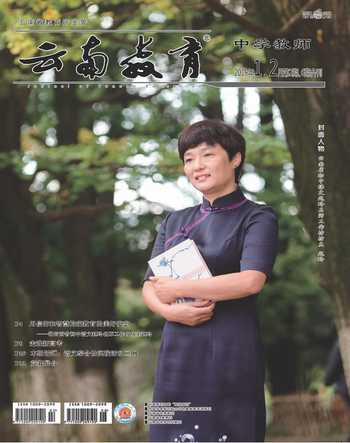高中英语读后课例设计
陶勇 王勇
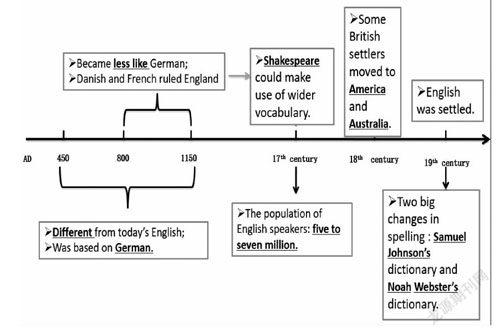
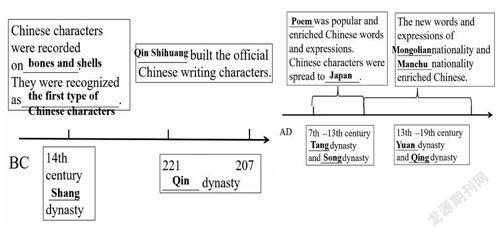
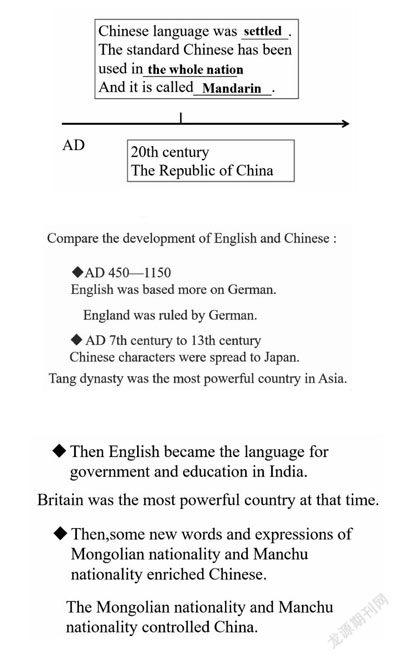
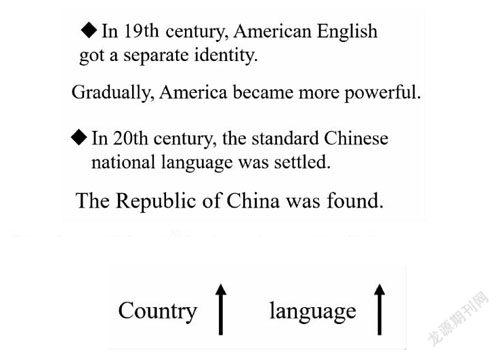

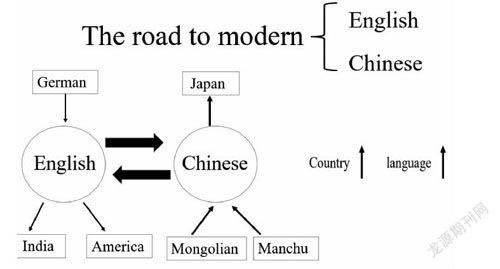
一、引言
普通高中英语课程的总目标是全面贯彻党的教育方针,培养和践行社会主义核心价值观,落实立德树人根本任务,在义务教育的基础上,进一步促进学生英语学科核心素养的发展,培养具有中国情怀、国际视野和跨文化沟通能力的社会主义建设者和接班人(普通高中英语课程标准,教育部,2017)。英语学科核心素养主要包括语言能力、文化意识、思维品质和学习能力。
阅读课教学是高中英语教学的重点,讀后活动有着极其重要的作用。“读前——读时——读后”三阶段阅读活动模式是现在高中英语阅读课普遍采用的模式。读后活动侧重检查阅读效果以及对所学语言的应用和巩固,使学生能在阅读的基础上将与阅读材料相关的主题内容、观点和所学知识点结合起来,进行语言输出。
本课例依据英语学科核心素养的要求,围绕本单元语言与文化交流融合的主题,旨在帮助学生树立人类命运共同体意识和多元文化意识,形成开放包容的态度,发展健康的审美情趣和良好的鉴赏能力,加深对祖国文化的理解,增强爱国情怀,坚定文化自信,树立正确的世界观、人生观和价值观,从而塑造优秀的文化意识和思维品质。
读后课(post-reading)是阅读课的第三个环节,是一个巩固、提升和拓展的环节。在这个环节中,学生可以通过复述课文、角色扮演、讨论辩论、演讲、写作等活动形式对所学知识进行消化、运用,锻炼语言技能,提升写作、小组合作等学习能力。
二、教学分析
1. 分析教学内容
这是一节读后教学课。首先,学生需要借助时间轴回顾上一节课所学的阅读文本介绍的英语语言的发展历程;之后学生将会阅读一篇课外拓展的文章:The Road to Modern Chinese.
对于这篇文章,学生需要利用skimming的阅读技巧快速获取主旨大意,然后对比英语和中文两种语言的发展历程,挖掘其中影响语言发展的潜在因素。之后,学生之间展开讨论,思考在未来,英语和中文的发展将会发生什么变化,并且进行辩论“英语和中文谁将影响谁?结果是什么?”最后实现以读促写,学生需要收集辩论过程中思维碰撞产生的火花,整理成一篇短文。
2. 教学目标
文化意识、情感态度和思维品质:通过这节课,学生不仅回顾了英语的发展史,而且还学习了我们的母语——中文的发展史,学生将会树立人类命运共同体意识、多元文化意识和培养跨文化交流的意识,加深对祖国文化的理解,增强爱国情怀,并坚定文化自信。同时,学生思维的逻辑性、批判性以及创新性等也得到了锻炼。
三、教学重点与难点
本堂课的重点:学生需要用分析英语发展历程的方法举一反三,思考我们自己的母语的发展历程,通过对比两种语言的发展史,挖掘出影响语言发展的潜在因素。
本堂课的难点: 教师要引导学生打开思路,形成开放包容的态度,激发批判性思维,辩证地看待两种语言的影响与发展,有理有据地支撑自己的观点。
四、教学过程
1. 回顾上节课的内容
学生借助时间轴回顾阅读文本中介绍的英语语言的发展历程,然后教师请学生来讲述:
【设计解析】在不允许学生看课文的情况下,教师要求他们借助时间轴上已给的时间点和提示信息,回忆阅读中获取的信息,补全时间轴,并运用适当的关联词组织句子进行表达,锻炼学生的语言技能。此外,这样做还能激活学生上节课所学的内容,为拓展相关话题做了铺垫。
2.课外文本导入
当学生复述完英语的发展史后,教师进行承上启下的引导:
Teacher: As you can see, English has experienced so many changes and finally become one of the greatest languages in the world. Chinese is also one of the greatest languages. But do you know how our mother tongue has developed?
Teacher: Here are some pictures that can tell us the development of Chinese. Let’s see them and tell me what they are.
图一:关于中国古文字的图片,引出Chinese characters;
图二:兽骨上的汉字,引出Chinese written on bones;
图三:秦始皇一统天下的照片,引出Emperor Qin Shihuang and Qin dynasty;
图四:一张有成吉思汗头像的元朝地图,引出Mongolian nationality;
图五:一张清朝满族人的照片,引出Manchu nationality;
图六:一张号召大家讲普通话的标语图片,引出Putonghua/Mandarin。
【设计解析】这六张图片反映了中文发展历程中一些重要的事件,旨在给学生留下一个总体印象,为即将引出的新文本做铺垫,同时还可以顺势引出文本中的重点生词。
在展示完以上六张图片后,教师引出课外拓展的阅读文本“The Road to Modern Chinese”:
The Road to Modern Chinese
At first, about BC 14th century, in Shang dynasty, Chinese characters were recorded on bones or shells. It was recognized as the first type of Chinese characters. Then between about BC 221 and 207, Qin Shihuang, the first formal emperor in Chinese history, built a center government to control the main parts of China, which built the official Chinese writing characters.
Later, from about AD 7th century to 13th century, two great dynasties, Tang and Song, controlled China. It was so popular to write poems that there were a lot of various words and expressions to join Chinese language. At that time, Chinese characters were spread to Japan because Tang dynasty was the most powerful country in Asia. Then, between about AD 13th century and 19th century, some new words and expressions of Mongolian nationality and Manchu nationality enriched Chinese.
Finally, the Chinese national language was settled in 20th century, because the Republic of China began to use the standard Chinese in the whole nation. Now the standard Chinese language is called Mandarin.
學生人手一份阅读材料,先快速阅读并标记时间点(time point),然后教师给出一个中文发展的时间轴,并邀请学生在电子白板上填写句子,学生需要仿照之前英语发展的时间轴填空,并尝试根据时间轴上的信息复述中文的发展历程。
【设计解析】这篇关于中文发展史的文章,句式和叙述风格都跟课本中的阅读文本相似,便于学生理解和获取信息。此处由英语发展史转向中文发展史,让学生反观母语的发展历程,学以致用,学会整理和归纳中文的发展过程,从而实现英语语言的实践和输出。从情感和文化意识上,让学生体会到一门语言的复杂演变过程,感受中华文化的源远流长。
3.评价总结与对比思考
在学生完成复述之后,教师给予评价和总结:
Teacher: Through the history, we find that both English and Chinese have changed a lot and finally settled as great languages in the world.
Teacher: Now, let’s look through the history again and find out what changes have happened to English and Chinese. And why?
Teacher: From AD 450 to 1150, why was English based more on German?
Students: Because England was ruled by German during that time.
Teacher: Why were Chinese characters spread to Japan from AD 7th century to 13th century?
Students: Because Tang dynasty was the most powerful country in Asia.
Teacher: After that, why did English become the language for government and education in India?
Students: Britain was the most powerful country at that time.
Teacher: Then, some new words and expressions of Mongolian nationality and Manchu nationality enriched Chinese, why?
Students: Because the Mongolian nationality and Manchu nationality had controlled China.
Teacher: Why did American English get a separate identity in 19th century?
Students: Because America became more powerful gradually.
Teacher: Why was the standard Chinese national language settled in 20th century?
Students: Because the Republic of China was founded.
Teacher: What can you find from these events in language’s development?
Students: The country’s power will influence language’s development.
Teacher: Very good. Can you tell me the specific relationship between the country’s power and language’s development?
Students:If a country becomes stronger and more powerful, its language will influence other languages deeply.
【设计解析】教师复现英语和中文发展史上的关键节点,让学生结合时代背景思考其变化的原因,深入挖掘一门语言与其国家实力之间的联系,从而得出结论:语言相互影响的背后,是国与国之间实力的角逐。如果一個国家国力强大,则该国的语言对其他国家的语言有输出影响。
4. 思考中英语言之间的相互影响
在学生总结出语言相互影响的背后,是国与国之间实力的角逐之后,教师进一步提出问题,提升学生的思维层次:
Teacher: In 21st century, when Chinese meet English, how will they influence each other? Now, think about the influence on Chinese and on English. You can do the brainstorming with your partners.
Teacher and students come up with some ideas:
关于英语对中文的影响:
咖啡coffee;互联网Internet;绿色食品 green food;因吹斯汀(interesting)滑稽有趣的;“我想打个taxi”;“我要成为CEO,走向人生巅峰!”
- 你真好看!
-(旧时)哪里啦,没有没有。
-(现在)谢谢你!
得出结论:English enriches Chinese vocabulary and expression, and changes people’s thoughts. Also, China has the largest number of English learners.
关于中文对英语的影响:
Tai Chi 太极;Kungfu 功夫;The Great Wall 长城;panda 熊猫;Sharing bike 共享单车;square dance 广场舞;mountain people mountain sea 人山人海;Long time no see. 好久不见;The Belt and Road.一带一路。
得出结论:Chinese enriches English vocabulary and Chinese culture are introduced and spread with expressions.
In a word, all languages change and develop when cultures meet and communicate. (这句话来自课文)
5.思维拓展及讨论
至此, 教师进一步发问:
Teacher: English and Chinese have influenced each other. So, what’s the final result in future? Here are three possible results. Which one do you prefer?
Teacher: Now, let’s make a debate. Choose the opinion which you agree with. It’s an open question so hold your idea and give supporting reasons. I will give you an example:
I support the result A that there will be only one language. I think it’s convenient and easy for us to use just one language to communicate. What’s more, we don’t need to spend so much time learning the second language.
Teacher(after students’ expression): What will the language be in future? Only time will tell. (这句话来自课文)
【设计解析】 随着思维深度的层层递进,学生逐步明白语言之间相互影响的背后是国与国之间实力的角逐,当今中文与英语的相互影响,体现出两种文化的碰撞与交融。通过这几个环节,学生的思维更加开阔了,课堂气氛活跃,文化意识也迸发出来了。当学生的思维火花四溢时,教师进一步提出一个更深层次的辩论问题:未来的语言是中文取代英文还是英文取代中文,抑或是多种语言融合形成一门新的语言?这是一个开放性的问题,教师做了一个示范性的观点陈述,学生可以持自己的观点,但是要有理有据。学生在自由陈述其观点时,要在纸上记下主要论据。因为本节课最后还要以读促写,学生的课后作业便是整理辩论的发言,将其观点写成一篇小议论文。
6. 布置作业
Collect the reasons of classmates for the same result. Then finish a short article with the clear parts: your idea, supporting reasons and conclusions.
五、板书设计
六、结语
阅读课教学在高中英语教学中有着极其重要的作用,有助于单元话题的延伸、语言的应用与检测,最重要的是有利于培养学生的核心素养。这是一节普通的高中英语读后课例设计,在高中英语学科核心素养培养目标的指导下,围绕本单元语言与文化交流融合的主题,旨在帮助学生拓展思维,提升思维层次,培养批判性思维,树立人类命运共同体意识和多元文化意识,形成开放包容的态度,发展健康的审美情趣和良好的鉴赏能力,加深对祖国文化的理解,增强爱国情怀,坚定文化自信,树立正确的世界观、人生观和价值观,从而培养优秀的文化意识和思维品质。

